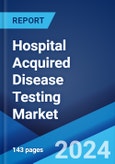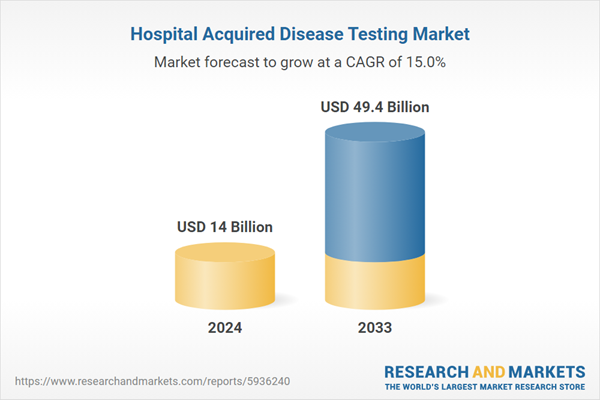The global hospital acquired disease testing market size reached USD 14.0 Billion in 2024. Looking forward, the market is forecast to reach USD 49.4 Billion by 2033, exhibiting a growth rate (CAGR) of 15% during 2025-2033. There are several factors that are driving the market, which include the rising geriatric population, increasing prevalence of hospital acquired infections (HAIs) like urinary tract infections (UTIs), bloodstream infections, and pneumonia, and the growing number of people undergoing different surgical procedures.
Hospital-acquired infections (HAIs) or nosocomial infections are diseases that are acquired in hospitals and medical clinics. Nosocomial means, infections or diseases originating in a hospital. A person can get such diseases even in the vicinity of a nursing home, rehabilitation center, hospital or any other clinical surroundings. Most people get HAIs when they are in intensive care units (ICUs) and emergency rooms (ERs). Generally, the incubation period of these diseases vary between 48 hours to 4 days after the individual gets admitted. A major reason behind the cause of hospital-acquired diseases is the lack of proper hygiene in the hospital settings by the internal staff. Other reasons can be below-par maintenance, complacency by the hospital staff, and a rise in multi-drug resistant organisms (MDROs). Some of the most commonly occurring nosocomial infections include pneumonia, primary bloodstream infections, urinary tract infections, etc. In many cases, it has also been found that these nosocomial infections are sometimes traced to the patient's own microbiome. It happens when the protective skin layer comes in contact with possible threats and causes infection to occur, especially after surgical operations.
This report provides an analysis of the key trends in each segment of the market, along with forecasts at the global and regional for 2025-2033. The report has categorized the market based on indication.
This report provides a deep insight into the global hospital-acquired disease testing market covering all its essential aspects. This ranges from macro overview of the market to micro details of the industry performance, recent trends, key market drivers and challenges, SWOT analysis, Porter’s five forces analysis, value chain analysis, etc. This report is a must-read for entrepreneurs, investors, researchers, consultants, business strategists, and all those who have any kind of stake or are planning to foray into the hospital-acquired disease testing market in any manner.
2. What is the global hospital acquired disease testing market growth 2025-2033?
3. What are the global hospital acquired disease testing market drivers?
4. What are the key industry trends in the global hospital acquired disease testing market?
5. What is the impact of COVID-19 on the global hospital acquired disease testing market?
6. What is the global hospital acquired disease testing market breakup by indication?
7. What are the major regions in the global hospital acquired disease testing market?
8. Who are the key companies/players in the global hospital acquired disease testing market?
Hospital-acquired infections (HAIs) or nosocomial infections are diseases that are acquired in hospitals and medical clinics. Nosocomial means, infections or diseases originating in a hospital. A person can get such diseases even in the vicinity of a nursing home, rehabilitation center, hospital or any other clinical surroundings. Most people get HAIs when they are in intensive care units (ICUs) and emergency rooms (ERs). Generally, the incubation period of these diseases vary between 48 hours to 4 days after the individual gets admitted. A major reason behind the cause of hospital-acquired diseases is the lack of proper hygiene in the hospital settings by the internal staff. Other reasons can be below-par maintenance, complacency by the hospital staff, and a rise in multi-drug resistant organisms (MDROs). Some of the most commonly occurring nosocomial infections include pneumonia, primary bloodstream infections, urinary tract infections, etc. In many cases, it has also been found that these nosocomial infections are sometimes traced to the patient's own microbiome. It happens when the protective skin layer comes in contact with possible threats and causes infection to occur, especially after surgical operations.
Market Trends
Catalyzed by rising population and modernization of the healthcare infrastructure, there has been a significant increase in the number of health care facilities across the globe. This has resulted in a rising incidence of HAIs, driving the demand of hospital acquired disease tests. Moreover, with advanced technologies and scientific innovations, various techniques are now available in the market for preventing, diagnosing, and monitoring HAIs such as microarrays, polymerase chain reaction (PCR), real time location systems (RTLSs), and solid phase hybridization. Techniques such as RTLS makes it easy to prevent HAIs from spreading in both patients and staff. Growing awareness of HAIs among patients and governments enacting regulations that penalize hospitals having a high incidence of HAIs are some of the other factors that are catalyzing the growth of the market.Market Segmentation
This report provides an analysis of the key trends in each segment of the market, along with forecasts at the global and regional for 2025-2033. The report has categorized the market based on indication.Breakup by Indication
- UTI (Urinary Tract Infection)
- SSI (Surgical Site Infection)
- Pneumonia
- Bloodstream Infections
- MRSA (Methicillin-Resistant Staphylococcus Aureus)
- Others
Regional Insights
- North America
- Europe
- Asia Pacific
- Middle East and Africa
- Latin America
Competitive Landscape
The competitive landscape of the market has also been examined with some of the key players being Abbott Laboratories, Alere, Inc., Becton, Dickinson and Company, bioMérieux SA, F. Hoffmann-La Roche Ltd., Hologic, Inc., QIAGEN, Siemens Healthcare, Diatherix Laboratories, Inc., Meridian Bioscience, Inc., Thermo Fisher Scientific, Inc. (Life Technologies Corporation) and Cepheid, Inc.This report provides a deep insight into the global hospital-acquired disease testing market covering all its essential aspects. This ranges from macro overview of the market to micro details of the industry performance, recent trends, key market drivers and challenges, SWOT analysis, Porter’s five forces analysis, value chain analysis, etc. This report is a must-read for entrepreneurs, investors, researchers, consultants, business strategists, and all those who have any kind of stake or are planning to foray into the hospital-acquired disease testing market in any manner.
Key Questions Answered in This Report
1. What is the market size for the global hospital acquired disease testing market 2024?2. What is the global hospital acquired disease testing market growth 2025-2033?
3. What are the global hospital acquired disease testing market drivers?
4. What are the key industry trends in the global hospital acquired disease testing market?
5. What is the impact of COVID-19 on the global hospital acquired disease testing market?
6. What is the global hospital acquired disease testing market breakup by indication?
7. What are the major regions in the global hospital acquired disease testing market?
8. Who are the key companies/players in the global hospital acquired disease testing market?
Table of Contents
1 Preface3 Executive Summary
2 Scope and Methodology
4 Introduction
5 Global Hospital Acquired Disease Testing Market
6 Market Breakup by Indication
7 Market Breakup by Region
8 Competitive Landscape
List of Figures
List of Tables
Companies Mentioned
- Abbott Laboratories
- Alere Inc.
- Becton
- Dickinson and Company
- bioMérieux SA
- F. Hoffmann-La Roche Ltd.
- Hologic Inc.
- QIAGEN
- Siemens Healthcare
- Diatherix Laboratories Inc.
- Meridian Bioscience Inc.
- Thermo Fisher Scientific
- Inc. (Life Technologies Corporation)
- Cepheid Inc.
Methodology

LOADING...
Table Information
| Report Attribute | Details |
|---|---|
| No. of Pages | 146 |
| Published | February 2025 |
| Forecast Period | 2024 - 2033 |
| Estimated Market Value ( USD | $ 14 Billion |
| Forecasted Market Value ( USD | $ 49.4 Billion |
| Compound Annual Growth Rate | 15.0% |
| Regions Covered | Global |
| No. of Companies Mentioned | 14 |









